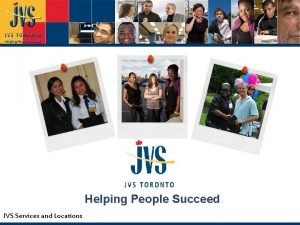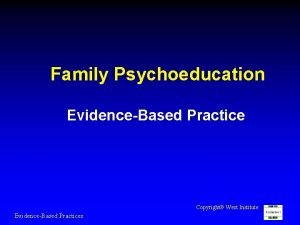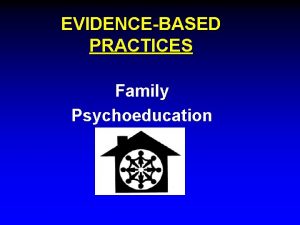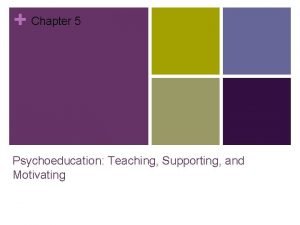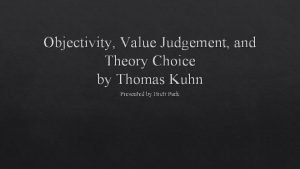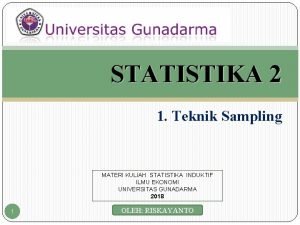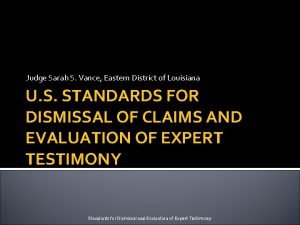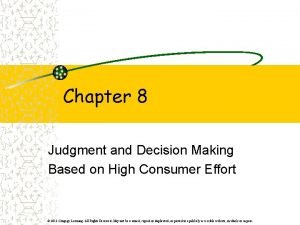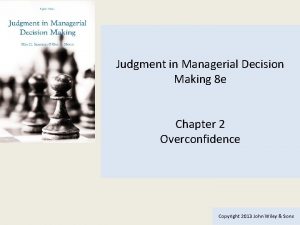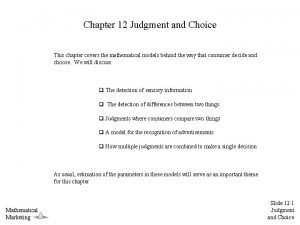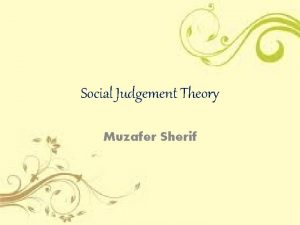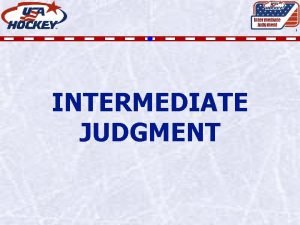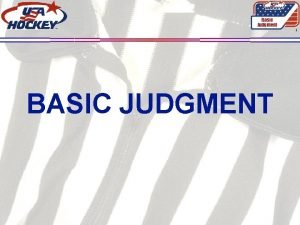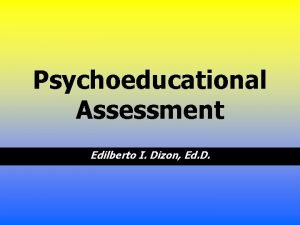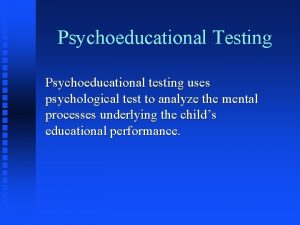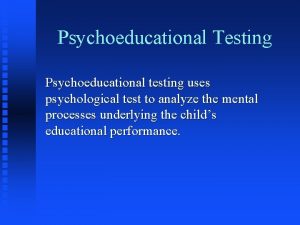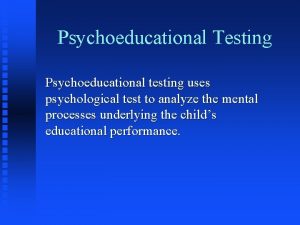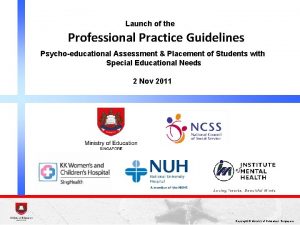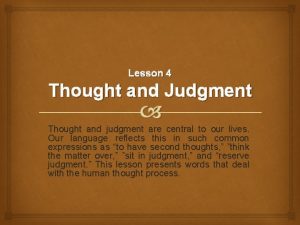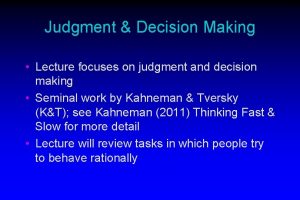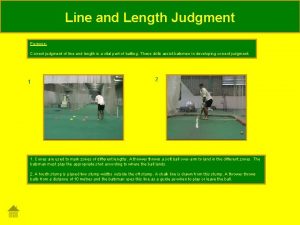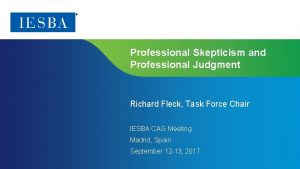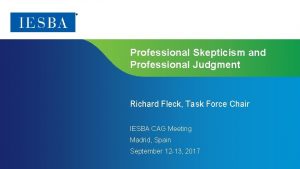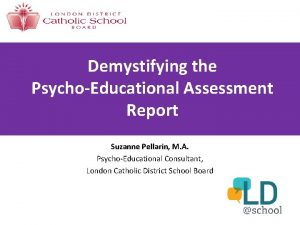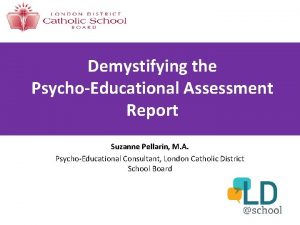Professional Judgment vs Psychoeducational Assessment for LD and


















- Slides: 18

Professional Judgment vs. Psychoeducational Assessment for LD and ADHD: An Interactive Approach

Tertiary Documentation: Information From External or Third Parties Documentation from external sources may include educational or medical records, reports and assessments created by health care providers, school psychologists, teachers, or the educational system…External documentation will vary in its relevance and value depending on the original context, credentials of the evaluator, the level of detail provided, and the comprehensiveness of the narrative. However, all forms of documentation are meaningful and should be mined for pertinent information.

Psychoeducational Assessments • Generally speaking, diagnostic testing reports (documentation) for Learning Disabilities and ADHD, all contain the same type of information. • Sections usually found in documentation include: o Tests Administered o Referral o Background Information o Behavioral Observation o Test Results & Discussion o Summary of Findings & Recommendations

Tests Administered • This section contains a list of all assessments completed. (example below) o Clinical Interview o Behavioral Observations o Conners’ Continuous Performance Test-Second Edition o Nelson-Denny Reading Test, Regular and Extended Time Versions o Wechsler Adult Intelligence Scale – IV o Woodcock-Johnson III – Tests of Achievement

Referral • This section usually contains information about who referred the individual for assessment and why. (example below) Miguel is a second-year law student who self-referred to the Student Psychological and Testing Center. He presented with concerns about a slow reading rate that is affecting his ability to keep up with course work and to complete exams within the allotted time.

Background Information • In the Background Information section, medical information (including developmental information), biographical information, educational information, social information, and information about the individual’s family, is found. (example below & on next slide) Patsy, a twenty-nine year old, Caucasian, female, is a student in the micro-computer specialist program. Patsy recalls participating in resource classes from the third grade through high school…she claims she got bored very quickly in high school and that she spent most of her time daydreaming in class.

Background Information (continued) At the beginning of the 2006 spring semester, Patsy was enrolled in nine hours of classes. However, she has since dropped one of her courses (Painting I). She is still attending her Intro to Computers and Information Systems class and her Intro to DOS class. Patsy explained that she enjoys these classes very much; while the DOS class is the most challenging one for her, she’s still making progress in the class. She explained that she learns best by simply experimenting with the computer and asking questions. She stated that she has not actually read the textbook yet, but has managed to stay ahead of the class with her hands-on activities. When asked why she hadn’t attempted to read the book, she explained that she can’t learn that way. She further stated that the book didn’t make sense to her, that reading was boring, and that she needs to manipulate the keyboard to see the effects on the screen to learn.

Behavioral Observation • The purpose of the Behavioral Observation section is to observe the individual as he/she processes through the assessment battery and to then clearly and concretely delineate exactly how the individual being evaluated, performs each of the steps in the learning process. (example on next two slides)

Behavioral Observation (continued) …The first session began with the administration of the Bender-Gestalt Test and the Benton Revised Visual Retention Test. Alfred was able to reproduce the figures with great accuracy. However, it took him almost two hours to complete what typically takes less than thirty minutes to complete. He also kept a running commentary going throughout the tests. He told jokes and stories and made various unrelated comments as he worked to reproduce the designs. …During the second assessment session, Alfred completed both the Woodcock-Johnson Test of Cognitive Abilities and Tests of Achievement. He began strong on the beginning subtests but became slower and talked almost continuously during the math calculation subtest.

Behavioral Observation (continued) He also utilized a series of unsophisticated methods to work the math problems (i. e. , he used his fingers to add and subtract and used “hash marks” on paper to multiply. Alfred scored much higher on the applied math subtest items during the third assessment session, than he did on the calculation subtest items. This time he seemed to understand the problems better because they were not presented in a void, but rather with the background details one finds in applied (word) problems. However, he still talked his way through the subtests. In fact the only time Alfred wasn’t talking, telling jokes, or telling stories was during the Dictation and Writing Samples subtests. On both of these subtests he was noticeably silent and if he made comments at all, it was between stimulus items and not during his response to the items.

Testing Results with Discussion of Findings • The scores and a brief discussion of the findings from the assessments administered will be in this section of the documentation. (example below & on next slide) Woodcock Johnson III – Tests of Achievement Broad Reading Letter-Word Identification Passage Comprehension Reading Fluency 73 75 80 75 Broad Mathematics Calculation Applied Problems Math Fluency 85 93 84 63

Tests Results and Discussion of Findings (cont. ) …Most significant are Ashley’s fluency scores. Her fluency scores (Reading Fluency, Math Fluency & Writing Fluency) range from a low of 63 to a high of 75 all of which fall more than a standard deviation below her Verbal Comprehension Index score of 98. In fact, her Academic Fluency score (an aggregate of her Reading, Math and Writing Fluency) is almost two standard deviations lower than her Verbal Comprehension Index score; her Math Fluency score is over two standard deviations lower.

Summary of Findings and Recommendations • This section begins with a brief summary of the assessment results (standardized tests). This is followed by a statement of whether or not the individual has a disability. Finally, accommodation recommendations are made. (example below & on next slide) Blake has a long history of Attention Deficit Disorder. Overall, many of his cognitive abilities are well within the average range, with a few significant strengths and weaknesses. Blake’s performance on the WAIS-IV indicates that he has highly variable abilities in the areas of Processing Speed and Perceptual Reasoning, both areas that are negatively impacted by time constraints.

Summary of Findings and Recommendations (continued) Academically, Blake shows relative strengths in the areas of formulating and writing meaningful sentences (Written Expression, Writing Samples, ), decoding and reading comprehension (Letter-Word Identification, Passage Comprehension), and in the automaticity of reading, writing, and math skills (Academic Fluency). Relative weaknesses were noted in attending to directions and sequencing responses (Understanding Directions) and in mathematical computation, reasoning, and abstract reasoning abilities/skills (Applied Problems). Blake has Attention Deficit Hyperactivity Disorder (ADHD)

Primary Documentation: Student’s Self-Report The student is a vital source of information regarding how he or she may be “limited by impairment. ” A student’s narrative of his or her experience of disability, barriers, and effective and ineffective accommodations is an important tool which, when structured by interview or questionnaire and interpreted, may be sufficient for establishing disability and a need for accommodation.

Primary Documentation: Student’s Self-Report Disability Services Intake Questionnaire Writing Sample & Interview

Secondary Documentation: Observation & Interaction The impressions and conclusions formed by higher education disability professionals during interviews and conversations with students or in evaluating the effectiveness of previously implemented or provisional accommodations are important forms of documentation. Experienced disability professionals should feel comfortable using their observations of students’ language, performance, and strategies as an appropriate tool in validating student narrative and self-report.

Secondary Documentation: Observation & Interaction Direct Observation Checklist
 Jvs jane and finch
Jvs jane and finch Psychoeducation
Psychoeducation Psychoeducation
Psychoeducation Psychoeducational model
Psychoeducational model Psychoeducational groups in schools
Psychoeducational groups in schools Objectivity value judgment and theory choice
Objectivity value judgment and theory choice John 16 5-15
John 16 5-15 The primary responsibility of all drivers is
The primary responsibility of all drivers is Contoh judgment sampling
Contoh judgment sampling Next generation nclex sample item types sample judgement
Next generation nclex sample item types sample judgement Summary judgment definition
Summary judgment definition Judgment chapter 8
Judgment chapter 8 Paris and the golden apple summary
Paris and the golden apple summary Hume's fork examples
Hume's fork examples Judgment in managerial decision making 8th edition
Judgment in managerial decision making 8th edition Pierre-auguste renoir the judgement of paris
Pierre-auguste renoir the judgement of paris Clinical judgment definition
Clinical judgment definition Judgment chapter 12
Judgment chapter 12 Contoh kasus social judgement theory
Contoh kasus social judgement theory
